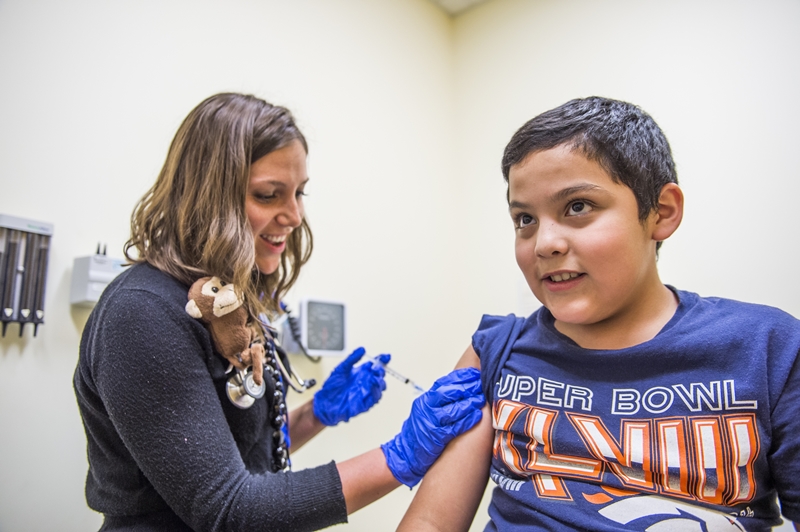If the thought of getting a shot brings about fears, tears and sleepless nights for your child, you’re not alone. Many children fear getting shots, but protecting your child from dangerous diseases is worth the challenge. The good news is that there are things you can do to help your child cope.
Our child life specialists have created a list of tried-and-true tips to help parents calm children who may be facing a fears of shots, immunization or other frightening procedure.
-
Tips to help your child who's scared of needles
- Be honest: Explain that shots can pinch, but that it won’t hurt for long. Help your child focus on what they can do to help get through the shot.
- Focus on health: Remind your child that immunizations help protect them from getting sick.
- Bring distractions: Bring comforting items, like a favorite book or stuffed animal, to help calm and distract your child.
- Sit up: Ask the provider if your child can sit up instead of lie down for the shot. Children are more fearful when having to lie flat. If your child needs help holding still, try holding your child in a firm but comforting position on your lap.
- Use vibration: Apply vibration near the needle injection site prior to the shot to help minimize pain. A simple vibrating massager can help, but there are vibrating and cooling tools made specifically for this purpose.
- Keep your cool: Try your best to appear calm and keep a positive attitude. Your child will be more anxious if they sense that you are anxious as well.
- Use coping strategies: Encourage your child to use coping strategies, and practice the strategies before the appointment.
-
Coping strategies for children
Coping strategies can help your child overcome their fear of shots and other challenging situations. Learning coping skills takes practice, so you may need to help your child adopt these strategies.
Guide your child through the different steps outlined below, then work to make these coping strategies part of their everyday routine. You can also model how you use coping strategies to face your own challenges and fears, which will help your child better understand their value.
- Deep breathing: Take 3-5 deep breaths. Take a big breath through your nose, then blow out through your mouth. To practice, make a paper flower and put to your nose to pretend. “Let’s smell the flower, now let’s blow it away.” You can blow a pinwheel or bubbles as practice, too. Do this before, during and after the shot.
- Squeezing: Before your child gets their shot, have them squeeze their hands together or around a ball; squeeze and hold for five seconds, then release. Repeat this 3- 5 times. If this works well, you can also try tightening other parts of the body and then releasing. For example, close eyes tight and scrunch face for five seconds, then release. Start with the face and work down to the toes.
- Music: Sing or listen to soft music.
- Imagery: Before the shot, picture a favorite place or activity. Think about what you see, hear, smell and feel when you are there. Try to stay in this calming place during the shot.
-
Coping strategies for infants
Infants need help facing stressful situations, too. Luckily, there are many things you can do to help your baby cope with immunizations or other potentially frightening situations.
- Swaddle: Tightly wrap your baby in a blanket, leaving one leg out for the shot.
- Suck: Nurse your infant or provide them with a pacifier to suck.
- Shushing sound/singing: Sing or shush softly in your baby’s ear.
- Skin-to-skin contact: Hold your baby close so they can feel your skin.
Original source: https://www.childrenscolorado.org/conditions-and-advice/parenting/parenting-articles/fear-of-shots/#:~:text=Focus%20on%20health%3A%20Remind%20your,lie%20down%20for%20the%20shot.
